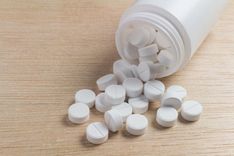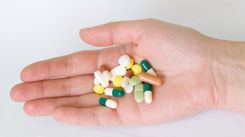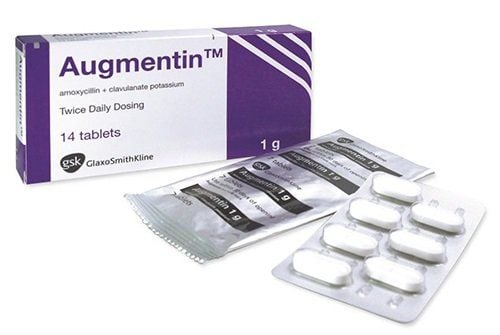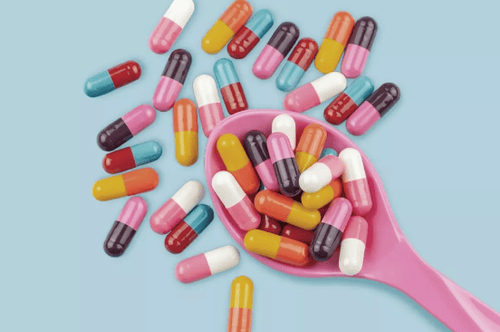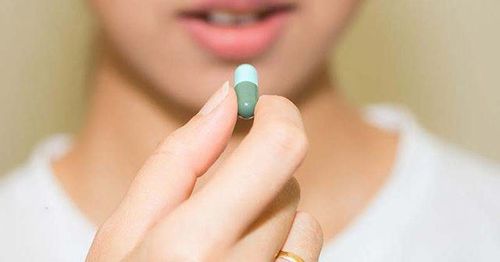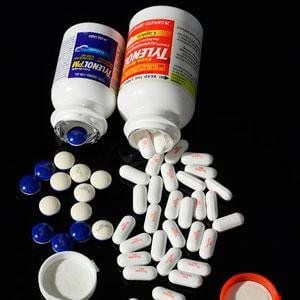1. What are the effects of Doxycycline 100mg?
Doxycycline 100mg is a type of antibiotic produced by Domesco Vietnam. The medication is formulated as hard capsules with blue caps and bodies, and the powdered content inside is uniformly yellow. Doxycycline 100mg works by eliminating parasites, fighting infections, or inhibiting the growth of viruses and fungi. Doxycycline 100mg belongs to the tetracycline group.
The components of Doxycycline 100mg include:
- Doxycycline calcium: Oral solution 50 mg/5 ml.
- Doxycycline hyclate:
- Capsules: 50 mg, 100 mg.
- Extended-release capsules: 100 mg.
- Film-coated tablets: 100 mg.
- Powder for intravenous infusion: 100 mg and 200 mg.
- Doxycycline monohydrate:
- Capsules: 50 mg, 100 mg.
- Powder for oral solution: 25 mg/5 ml.
2. Indications and contraindications of Doxycycline 100mg
2.1. Indications
Doxycycline 100mg is indicated for the following cases:
- Treatment of bacterial infections caused by Gram-positive and Gram-negative bacteria, as well as certain other Doxycycline-sensitive strains.
Respiratory tract infections: Pneumonia caused by Chlamydia pneumoniae, Mycoplasma pneumoniae, Chronic bronchitis, sinusitis, Lower respiratory tract infections caused by sensitive strains of Streptococcus pneumoniae, Klebsiella pneumoniae, Haemophilus influenzae, and others.
Urinary tract infections: Infections caused by Klebsiella, Enterobacter spp., and other bacteria. Non-specific urethritis caused by Ureaplasma urealyticum.
Sexually transmitted diseases: Treatment of gonorrhea, syphilis, infections of the endometrium/anus, urethritis, and uncomplicated urethral infections.
Since Doxycycline 100mg belongs to the tetracycline group, it is also effective in treating bacterial infections responsive to this group, such as:
- Ocular infections: Trachoma caused by bacteria sensitive to Gonococcus, Staphylococcus, and Haemophilus influenzae.
- Rocky Mountain spotted fever, typhus, Q fever, endocarditis caused by Coxiella, and tick fever.
- Psittacosis, cholera, melioidosis, leptospirosis, and chloroquine-resistant falciparum malaria.
- Malaria prophylaxis for travelers visiting areas with resistant parasites.
- Brucellosis, cholera, atypical pneumonia, granuloma inguinale, erythema migrans, and relapsing fever.
- Periodontal disease treatment.
- Treatment of gonorrhea and syphilis
- Prevention and treatment of anthrax caused by Bacillus anthracis.
2.2. Pharmacodynamics
Doxycycline 100mg is a bacteriostatic antibiotic. Its primary mechanism of action involves inhibiting protein synthesis. It penetrates the lipid bilayers of bacterial cells and enters the cytoplasm through an energy-dependent active transport system.
Once inside, Doxycycline binds to the 30S ribosomal subunit of bacteria, blocking the addition of amino acids to the growing peptide chain. This inhibits protein synthesis, which is essential for bacterial survival. At high concentrations, Doxycycline also reduces protein synthesis in mammalian cells.
Doxycycline exhibits broad-spectrum antibacterial activity against aerobic and anaerobic Gram-positive and Gram-negative bacteria, as well as some antibiotic-resistant bacteria act on cell walls such as Rickettsia, Mycoplasma pneumoniae, Legionella spp., and Ureaplasma,... However, Doxycycline is not effective against fungal infections in clinical settings.
Doxycycline is less hepatotoxic and causes fewer local irritations, gastrointestinal disturbances, and intestinal dysbiosis. Additionally, this medication is preferred over other tetracyclines because it is better absorbed and has a longer half-life, allowing for less frequent dosing. Doxycycline can also be used in patients with renal impairment. Currently, in Vietnam, there is a high prevalence of drug-resistant pneumococci. Plasmodium falciparum, which is often resistant to multiple drugs such as chloroquine, sulfonamides, and other antimalarial medications, can still be effectively prevented using doxycycline.
According to reports, it is essential to carefully review information about antibiotics, including doxycycline, before use. This is because, in Vietnam, many bacterial strains such as E. coli, Shigella flexneri, and Enterobacter have developed resistance to doxycycline. Consequently, drug resistance rates vary depending on the region and timing.
2.3. Pharmacokinetics
- Absorption: Doxycycline 100mg is absorbed at 95% through the gastrointestinal tract, with food and milk having little effect on absorption. About 80–95% of Doxycycline in the blood is bound to plasma proteins. The drug can be taken twice a day, with a half-life of 16–18 hours. Maximum plasma concentration reaches 3 µg/ml approximately 2 hours after taking an initial 200 mg dose, and the plasma level remains above 1 µg/ml for 8–12 hours. Plasma levels are similar whether taken orally or intravenously.
- Distribution: Doxycycline is distributed into tissues and secretions, including urine and the prostate gland. It accumulates in the spleen, bones, bone marrow, reticuloendothelial cells of the liver, dentin, and unerupted tooth enamel. Doxycycline is more lipophilic than tetracyclines.
- Excretion: The half-life is typically 12–24 hours. Doxycycline is primarily excreted in feces (via the liver) and, to a lesser extent, in urine (via the kidneys). This makes it the safest option for treating infections in patients with renal impairment. However, since Doxycycline is minimally excreted through the kidneys, higher doses are often combined for treating urinary tract infections.
3. Dosage of Doxycycline 100mg Tablets
It is important to use the medication as prescribed by your doctor. Always take the medication with a full glass of water. It is recommended to take the medication after meals or with milk for those who have stomach discomfort. However, consuming the medication with food may reduce its absorption.
Patients should take the medicine during or after meals with plenty of water, in an upright standing or sitting position.
- Adults: On the first day: Take 1 tablet twice a day. On the following day: Take 1 tablet once in the day. For severe infections: Take 1 tablet twice a day.
- Children (above 8 years old): On the first day: 4-5 mg/kg per day, divided into two doses. On the second day: 2-2.5 mg/kg, once in the day. For severe infections: 2-2.5 mg/kg, divided into two doses per day.
- Severe infections: Adults: Take 2 tablets once a day.
- For Streptococcus infections: Treatment should last for 10 days to prevent rheumatic fever or glomerulonephritis.
- For acute gonococcal infection: Take 2 tablets + 1 tablet in the evening on the first day, then 1 tablet twice daily for the next 3 days.
- For urethral infections, or infections inside the cervix/vagina due to Chlamydia trachomatis and Ureaplasma urealyticum: Take 1 tablet twice a day, for at least 10 days.
- No dose adjustment is required for patients with renal impairment since Doxycycline is primarily excreted via the liver and gastrointestinal tract.
4. Drug interactions
- Antacids containing aluminum, calcium, or magnesium will decrease the absorption of Doxycycline in the body.
- Iron salts and bismuth subsalicylate may reduce the bioavailability of Doxycycline.
- Barbiturates, phenytoin, and carbamazepine can decrease the half-life of Doxycycline by increasing its metabolism.
- Calcium, iron, magnesium, zinc, and amino acids
- Anticoagulants (e.g., warfarin)
- Carbamazepine
- Rifampicin
- Methoxyflurane
- Penicillin
- Retinoic acid
5. Precautions When Using Doxycycline
- In Children Under 8 Years Old, Doxycycline 100mg can cause permanent tooth discoloration, enamel hypoplasia, and reduced growth rate of bones. Therefore, the medication should not be used in this age group.
- Long-term use of Doxycycline should be limited, as it may lead to fungal and bacterial superinfections.
- Avoid prolonged sun exposure while using Doxycycline, as it can cause photosensitivity.
- Take the medication with at least one full glass of water while standing. This helps to prevent esophageal ulcers and reduces gastrointestinal irritation.
- Alcohol consumption may lower the effectiveness of the drug, potentially leading to subtherapeutic levels.
- The use of Doxycycline in delayed-release capsules may promote the growth of certain microorganisms, such as Candida.
- Inform your doctor if you are using oral contraceptives, planning to become pregnant, or are breastfeeding.
6. Special Considerations
6.1. Pregnant Women
- Tetracyclines, including Doxycycline, are known to cross the placenta.
- In the second and third trimesters of pregnancy, Doxycycline should not be used because it may cause permanent tooth discoloration, enamel hypoplasia, and abnormal bone development.
- Pregnant women may also be at risk of developing fatty liver disease, especially when administered high doses via intravenous injection.
6.2. Breastfeeding Women
- Doxycycline is excreted into breast milk, forming a complex with calcium in the milk that cannot be absorbed.
- Breastfeeding women should avoid taking Doxycycline. If the medication is necessary, breastfeeding should be discontinued.
7. Side Effects When Using Doxycycline
When using Doxycycline 100mg, patients may experience some unwanted side effects, including:
- Allergic Reactions: These can include anaphylaxis and anaphylactic shock; difficulty breathing, low blood pressure, rapid heart rate, hives, allergic purpura, pericarditis, angioedema, lupus flare-up, serum sickness, and peripheral angioedema.
- Infections and Parasitic Infections: Overgrowth of Clostridium difficile and overgrowth of the genital area can occur.
- Blood and Lymphatic Disorders: Hemolytic anemia, thrombocytopenia, neutropenia, eosinophilia, and porphyrin metabolism disorders.
- Endocrine Disorders: Prolonged use may cause dark brown or black discoloration of thyroid tissue.
- Neurological Disorders: Headache, bulging fontanel in infants, and benign intracranial hypertension. These symptoms will resolve after stopping the medication. However, symptoms like double vision, scotoma, and permanent vision loss have been reported.
- Ear and Auditory Disorders: Tinnitus (ringing in the ears).
- Gastrointestinal Disorders: Mild symptoms like abdominal pain, loss of appetite, nausea, diarrhea, and stomatitis. Esophagitis and esophageal ulcers have also been reported. Long-term use can lead to tooth discoloration and reduced enamel strength.
- Hepatic and Biliary Disorders: Hepatitis, liver failure, pancreatitis, and jaundice.
- Skin and Subcutaneous Tissue Disorders: Rashes, including maculopapular rash and erythema, exfoliative dermatitis, erythema multiforme, Stevens-Johnson syndrome, toxic epidermal necrolysis, nail shedding, and photosensitivity.
- Musculoskeletal Disorders: Joint pain and muscle pain.
- Renal and Urinary Disorders: Elevated blood urea levels.
- Reproductive and Breast Disorders: Vaginal infections.
Doxycycline 100mg, as part of the tetracycline class of antibiotics, is effective at killing parasites, fighting infections, and preventing the growth of viruses and fungi. To ensure treatment effectiveness and avoid unwanted side effects, patients should follow the prescribed instructions from healthcare professionals.
For more health, nutrition, and beauty information, visit the Vinmec International General Hospital website to stay informed and protect your health and that of your family.
To arrange an appointment, please call HOTLINE or make your reservation directly HERE. You may also download the MyVinmec app to schedule appointments faster and manage your reservations more conveniently.


